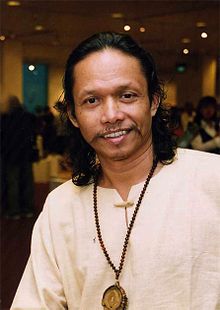- Mohammad Din Mohammad
-
Mohammad Din Mohammad 
Born 24 May 1955
Kampung Gangsa, Durian Tunggal
Malacca, MalaysiaDied 2007
SingaporeMohammad Din Mohammad is a Singaporean Malay painter who is known for his expressive works of art inspired by Sufism. Mohammad's paintings and sculptures are also heavily influenced by his devotion to the practice of the Malay martial arts called silat.He was also a practising bomoh, or Malay healer.[1]
Born in Kampung Gangsa in Malacca, Malaysia, Mohammad's family migrated to Singapore when he was two years old. As a boy he was interested in art, experimenting in ceramics, making clay cups at the age of five. Formal education for Malay youths, meant the study of traditional art forms at the time.[2] At the age of 12, Mohammad began to learn silat and traditional massage and herbal healing techniques. In 1973, Mohammad went on to study art at the Nanyang Academy of Fine Arts, majoring in western painting, where he took to the Realist portrait painting style. After graduating in 1976 he began his life as an artist plying on the old Bugis Street, and drawing portraits for tourists. This went on for the next 5 years.[3]
In 1980, Mohammad began acting with Malay theaters, with his first role as the character Laertees in a Malay adaptation of Hamlet by the Malay arts group Perkumpulan Seni.[4] He also acted in a Singaporean drama serial, Jejak Kembara (The Wanderer) in April 1980.[5]
In 1983, a severe motorcycle accident in Pontian nearly cost Mohammad his ankle. Though doctors managed to join back the ankle in place gangrene set in soon after the operation. Ignoring his doctor's plea to amputate, Mohammad sought traditional medical help from his silat master Hamin Bujang, and after two years' of treatment he was able to walk again. He became a strong believer in traditional Malay medicine, and went on to study and practice traditional healing techniques.[3]
Mysticism in his art
Mohammad is best remembered for his provocative work, which combines Western ideas with his cultural background. His works, especially his sculptures, are deeply rooted in Sufi mysticism, which he practiced throughout his life. Through his art, Mohammad seeks to "stitch" together his beliefs, and life philosophies into a common entity - an artwork that is 'an assembly of separated body and soul'.[6]
References
- ^ Mustafa, Shabbir Hussain (2008-10-01). "Nafas Magazine". http://universes-in-universe.org/eng/nafas/articles/2008/mohammad_din_mohammad. Retrieved 2009-03-23.
- ^ Atan, Mas Zetti (2008-07-06). "He had a dream". The Star. http://thestar.com.my/lifestyle/story.asp?file=/2008/7/6/lifearts/1506024&sec=lifearts. Retrieved 2009-03-22.
- ^ a b Rashid, Yaakub (1991-12-18). "Medicine man". Straits Times. p. 13.
- ^ Richard, Lim, ed (1998). "Mohammad Din Mohammad". Singapore Artists Speak. Singapore: Art & Artist Speak. pp. 176–179. ISBN 9971-0-0863-7.
- ^ "The good, the bad and the colourful". Straits Times. 1980-04-26. p. 3.
- ^ Tan, Bridget Tracy; Lim, Iris, eds (2008). Nanyang 70 years after - a reunion of artists in the academy. Singapore: Nanyang Academy of Fine Arts. pp. 112–113. ISBN 978-981-08-2057-2.
- Farrer, D. S. (2009). Shadows of the Prophet : martial arts and Sufi mysticism. Netherlands: Springer. ISBN 978-1-4020-9355-5.
External links
Categories:- 1955 births
- Singaporean people of Malay descent
- Singaporean painters
- Singaporean artists
- 2007 deaths
- Malaysian emigrants to Singapore
- Singaporean people stubs
Wikimedia Foundation. 2010.
